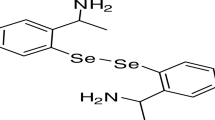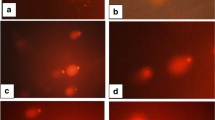Abstract.
Previous studies indicate that benzanthrone, an anthraquinone dye intermediate, caused significant depletion of ascorbic acid (AsA). In this investigation the effect of benzanthrone on the status of different forms of AsA and other bio-antioxidants such as glutathione (GSH) was studied. Oral administration of benzanthrone (50, 125 or 250 mg/kg body weight) resulted in a significant increase of urinary AsA levels with a concomitant decrease in the urinary dehydroascorbic acid (DHA) content in both rats and guinea-pigs. Benzanthrone caused a dose-dependent decrease in hepatic, adrenal and serum AsA levels with a subsequent increase in DHA and diketogulonic acid (DKA) levels in both rats and guinea-pigs. Following benzanthrone treatment, rats showed an increase in the scorbutic index (to 1.01–1.21) of the liver, adrenal glands and serum compared to controls (0.12–0.24). The scorbutic indices of liver, adrenal glands and serum were also substantially increased (to 3.61–11.20) in benzanthrone-treated guinea-pigs compared to controls (0.16–0.38). Single oral administration of benzanthrone to guinea-pigs caused a dose-dependent depletion of GSH in liver (15–51%), adrenal glands (27–64%) and serum (32–86%). Furthermore, the depletion of GSH by benzanthrone in rats was of a lesser degree. This suggests that continued exposure of guinea-pigs to benzanthrone may lead to scurvy-type changes in this animal species but not to the same extent in rats, since the latter has the enzymatic capacity to synthesise AsA. Therefore, it can be hypothesised that benzanthrone per se, or its metabolites, interact with reduced GSH thereby causing its depletion. Furthermore, in order to replenish the depleted GSH levels, AsA might be oxidized to DHA and hence the decrease in AsA with the simultaneous increase in DHA was observed.
Similar content being viewed by others
Author information
Authors and Affiliations
Additional information
Electronic Publication
Rights and permissions
About this article
Cite this article
Dwivedi, N., Das, M. & Khanna, S.K. Role of biological antioxidants in benzanthrone toxicity. Arch Toxicol 75, 221–226 (2001). https://doi.org/10.1007/s002040100222
Received:
Accepted:
Issue Date:
DOI: https://doi.org/10.1007/s002040100222




